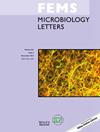Dynamic responses of Salmonella Typhimurium to re-exposure to sublethal ciprofloxacin
IF 2.2
4区 生物学
Q3 MICROBIOLOGY
引用次数: 0
Abstract
This study was designed to evaluate the history-dependent behaviors of Salmonella Typhimurium re-exposed to sublethal levels of ciprofloxacin. The S. Typhimurium cells were pre-exposed to 0 (CON), 1/16 (LOW), 1/8 (MED), and 1/4 (HIGH) MICs of ciprofloxacin, followed by re-exposure to the same concentrations. The bacterial growth, post-antibiotic effect (PAE), relative fitness, and swimming motility of treatments were evaluated in the absence of ciprofloxacin. The lag phase duration (LPD) was estimate to assess bacterial recovery under ciprofloxacin exposure. A disk diffusion assay was used to determine the cross-resistance and collateral sensitivity of CON, LOW, MED, and HIGH treatments to ciprofloxacin (CIP), ceftriaxone (CEF), erythromycin (ERY), gentamicin (GEN), and polymyxin B (POL). The S. Typhimurium cells pre-exposed to ciprofloxacin were susceptible in antibiotic-free media, showing delayed growth. The highest PAE (> 1 h) and bacterial fluctuation (CV = 5%) were observed at the High treatment compared to the CON. The HIGH treatment had the lowest relative fitness levels (0.87) and swimming motility (55 mm). The LPD was significantly decreased at the LOW treatment (1.8 h) when re-exposed to 1/16× MIC of ciprofloxacin. The LOW, MED, and HIGH treatments showed the cross-resistance to POL and the collateral sensitivity to CEF, ERY, and GEN. The pre-exposure to ciprofloxacin could induce phenotypic diversity, corresponding to the history-dependent behaviors. These results provide important insights for the dynamic nature of bacterial populations when re-exposed to sublethal concentrations of antibiotics.鼠伤寒沙门氏菌对再次接触亚致死环丙沙星的动态反应
本研究旨在评估再次暴露于亚致死浓度环丙沙星的鼠伤寒沙门氏菌的历史依赖行为。Typhimurium 沙门氏菌细胞先暴露于 0 (CON)、1/16 (LOW)、1/8 (MED) 和 1/4 (HIGH) MIC 的环丙沙星,然后再次暴露于相同浓度的环丙沙星。在没有环丙沙星的情况下,评估各处理的细菌生长、抗生素后效应(PAE)、相对适应性和游动性。通过估计滞后期持续时间(LPD)来评估细菌在环丙沙星暴露下的恢复情况。采用盘扩散试验来确定CON、LOW、MED和HIGH处理对环丙沙星(CIP)、头孢曲松(CEF)、红霉素(ERY)、庆大霉素(GEN)和多粘菌素B(POL)的交叉耐药性和附带敏感性。预先暴露于环丙沙星的鼠伤寒杆菌细胞对无抗生素培养基易感,表现出生长延迟。与 CON 相比,High 处理的 PAE(> 1 h)和细菌波动率(CV = 5%)最高。高处理的相对适合度水平(0.87)和游动能力(55 mm)最低。当再次接触 1/16 倍 MIC 的环丙沙星时,LOW 处理的 LPD 明显降低(1.8 h)。LOW、MED和HIGH处理显示了对POL的交叉抗性和对CEF、ERY和GEN的附带敏感性。预先暴露于环丙沙星可诱导表型多样性,与历史依赖行为相对应。这些结果为细菌种群再次暴露于亚致死浓度抗生素时的动态性质提供了重要启示。
本文章由计算机程序翻译,如有差异,请以英文原文为准。
求助全文
约1分钟内获得全文
求助全文
来源期刊

Fems Microbiology Letters
生物-微生物学
CiteScore
4.30
自引率
0.00%
发文量
112
审稿时长
1.9 months
期刊介绍:
FEMS Microbiology Letters gives priority to concise papers that merit rapid publication by virtue of their originality, general interest and contribution to new developments in microbiology. All aspects of microbiology, including virology, are covered.
2019 Impact Factor: 1.987, Journal Citation Reports (Source Clarivate, 2020)
Ranking: 98/135 (Microbiology)
The journal is divided into eight Sections:
Physiology and Biochemistry (including genetics, molecular biology and ‘omic’ studies)
Food Microbiology (from food production and biotechnology to spoilage and food borne pathogens)
Biotechnology and Synthetic Biology
Pathogens and Pathogenicity (including medical, veterinary, plant and insect pathogens – particularly those relating to food security – with the exception of viruses)
Environmental Microbiology (including ecophysiology, ecogenomics and meta-omic studies)
Virology (viruses infecting any organism, including Bacteria and Archaea)
Taxonomy and Systematics (for publication of novel taxa, taxonomic reclassifications and reviews of a taxonomic nature)
Professional Development (including education, training, CPD, research assessment frameworks, research and publication metrics, best-practice, careers and history of microbiology)
If you are unsure which Section is most appropriate for your manuscript, for example in the case of transdisciplinary studies, we recommend that you contact the Editor-In-Chief by email prior to submission. Our scope includes any type of microorganism - all members of the Bacteria and the Archaea and microbial members of the Eukarya (yeasts, filamentous fungi, microbial algae, protozoa, oomycetes, myxomycetes, etc.) as well as all viruses.
 求助内容:
求助内容: 应助结果提醒方式:
应助结果提醒方式:


